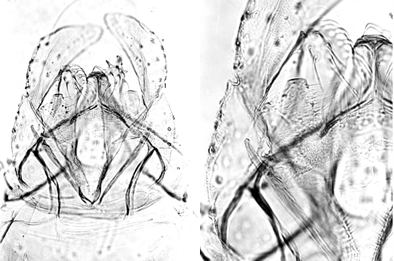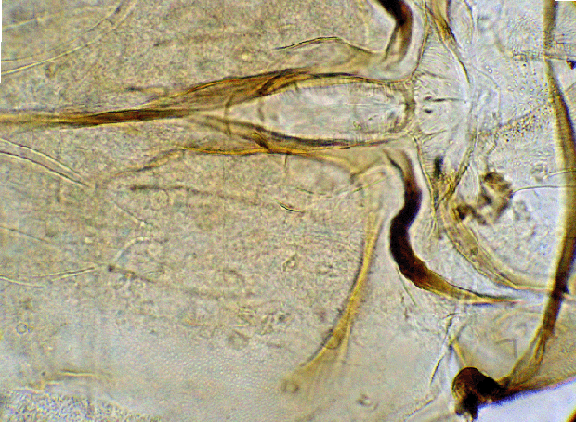C. 'queenslandicus' manuscript nameAdult  Note the distinctive short, hairy superior volsella (right). Face, antennae, palps, brown. Frontal tubercles present. AR about 2.84 - 3.1. Palp proportions (segs 2-5) (micron) 40 ; 170 ; 165+ : 250. Clypeal setae - 22. Thorax green, stripes reddish brown with a dark spot at the posterior end of the lateral stripes. Thoracic setae: Achrostichal - 16, Dorsolateral 11-13, Prealar - abt 4, Scutellar - 2 approximate rows, Ant. - 10, Post. - 12. Wings pale, halteres greenish. Wing length 3.20 mm; wing width 0.83 mm; VR 1.11. Legs pale. Anterior basitarsus not bearded. Ant LR = 1.76-1.80; F/T = 1.43; Ant Ta4 longer than Ta3. Leg proportions (micron):
Male terminalia distinctive due to short hairy superior volsella (SV), rather like that of Xenochironomus, and therefore does not fit any of Strenzke's types. This appendage appears to have an extensive membranous region which can fold rather differently during slide-mounting and so lead to quite variable appearance of the SV. Setae of inferior volsellae unbranched. Anal point broad, also as in Xenochironomus; styles only slightly tapered at the ends. Wing length: 3.26 mm. Wing width abt 0.85-0.86 mm. VR 0.87-0.90. Abt 22 setae on squamal fringe. Antennal segments (µm, % neck in brackets) (2): 158 (24) : 118 (40) : 118 (40) : 103 (35) : 229. Frontal tubercles: about 18-38 µm long, 10-13 µm wide. Palps (µm) (2): 39 : 41 : 157 : 212 : 307; P5/P4 1.39-1.52; P5/P3 1.89-2.03. Clypeal setae - abt 18-20. Thoracic setae: Achrostichal - abt. 17, Humeral 5-6 linear, Dorsocentral 11-14 (Humeral+dorsocentral 17-20), Prealar - abt 3-4, Scutellar - 2 approximate rows, Ant.- 6-9, Post. - 13-14 (total 20-22).Leg proportions (microns) (2): Fore Ta4 longer than Ta3 and Ta5, about same length as Ta2.BR 2.0-2.6. About 38-43 sensilla chaetica on hind Ta1. Segment X a moderately broad crescent (l/w at broadest point about 5.3) with about 6-7 setae; 2-3 setae on Gonocoxite IX.  Cercus essentially rectangular but with curved posterior margin, longest anterior/posterior, sometimes with a slight/moderate bulge at ventral base. About 7 setae on Gonopophysis VIII, 2-3 on Gonopophysis IX. Types: Holotype male: 4 km n. Fernvale, Queensland (27.43°S, 152.65°E), AQ.19.1, 8.vi.1968 (leg. Jon Martin) reared male #1 with pupal and larval exuviae, slide mounted. Found: New South Wales - ¿Lake Ainsworth. |
Modified: 14 June 2024
Access: Unrestricted
Copyright © 2005-2024, Jon Martin.